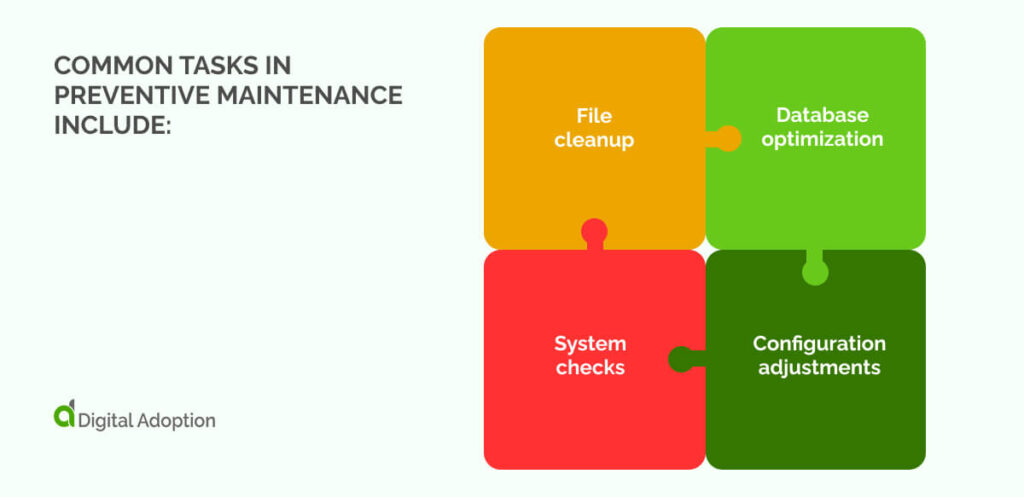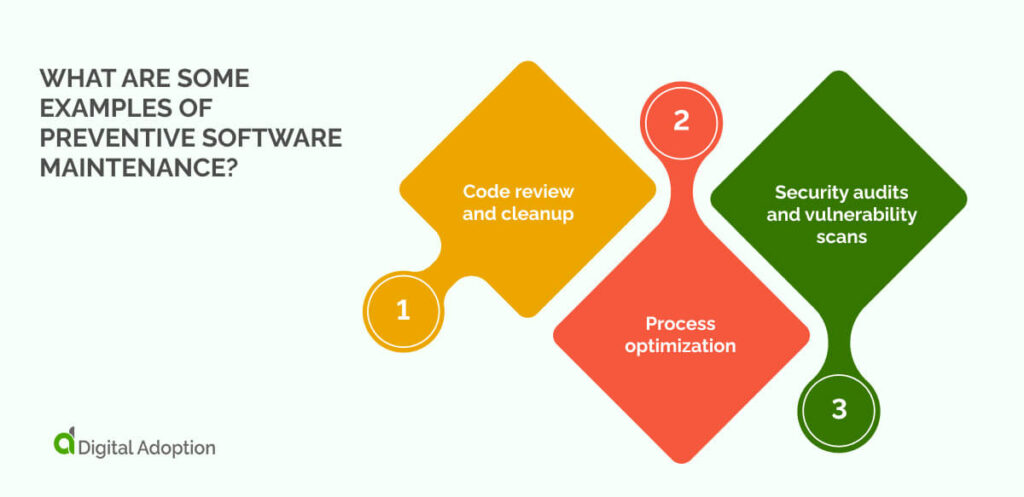The digital transformation wave sweeping across sectors has seen technology adoption increase tenfold.
The rush to innovate via the newest digital tools requires more than just sporadic investments. Managing a reliable and scalable software stack needs regular attention and maintenance.
Transparency into what happens inside enterprise technology is key to ensuring asset quality and reliability. Businesses and IT teams depend on these tools to run critical operations. Preventive maintenance helps in this regard and aims to identify and address potential issues before they impact system performance.
In this article, we’ll explore preventive maintenance and its importance. We’ll also examine how it works, how it differs from predictive methods, and how AI is expanding maintenance capabilities.
- What is preventive software maintenance?
- How does preventive software maintenance work?
- How is AI used in preventive software maintenance?
- What are the different types of preventive software maintenance?
- What are some examples of preventive software maintenance?
- What is the difference between preventive maintenance and predictive maintenance?
- How to perform preventive maintenance in software environments
- A future outlook on preventive maintenance
- People Also Ask
What is preventive software maintenance?
Preventive software maintenance is a type of maintenance aimed at identifying and resolving potential software issues before they develop into actual problems.
This proactive approach includes regular activities such as bug fixes, performance checks, updating code, patching security holes, and optimizing data. The goal is to prolong the lifespan and enhance the quality of software applications.
By ensuring that systems operate smoothly and are resistant to breakdowns, preventive software maintenance improves the effectiveness of solutions as they evolve and adapt. These actions help prevent critical issues and increase uptime throughout the software lifecycle.
Artificial intelligence (AI) and machine learning (ML) algorithms are increasingly used in preventive software maintenance. They analyze data to predict potential software failures, allowing maintenance teams to address issues before they disrupt operations.
How does preventive software maintenance work?
Preventive software maintenance involves scheduled tasks aimed at ensuring systems remain healthy and perform optimally. These tasks are carried out proactively to reduce the likelihood of failures or performance issues.

Common tasks in preventive maintenance include:
- File cleanup: Removing outdated or unnecessary files that could slow down the system.
- Database optimization: Streamlining inefficient database queries to enhance system performance.
- System checks: Conducting routine inspections to ensure proper connections and functionality.
- Configuration adjustments: Tweaking settings to optimize software compatibility with new hardware or networks.
The process generally relies on pre-defined schedules and static monitoring tools to maintain system upkeep. While these practices are effective for routine maintenance, they fall short in capturing the live status of system health.
How is AI used in preventive software maintenance?
Preventive maintenance may not be able to leverage AI to detect system issues in real-time, but it can certainly use real-time insights to bolster preventive strategies.
Preventive measures rely on pre-defined schedules and procedures to carry out maintenance. AI can take over these tasks instead of relying on manual system checks, condition monitoring, and configurations.
It can accurately inform preventive schedules, making the process more efficient and less prone to human error.
While many preventive methods can become predictive ones when AI is involved, let’s break down how AI contributes to stand-alone preventive activities.
Predictive capabilities
AI can glean both historical and current data to create a live view of software performance and health. ML algorithms analyze this data to establish an operational baseline.
Painting a picture of operational norms means the AI can detect and predict unusual or hidden anomalies that may cause potential failures. This analytical insight can then strengthen preventive strategies that inform future maintenance checks.
Condition-monitoring
Resource usage, server loads, and error rates help assess software systems. Manually measuring these while scheduling preventive fixes is a tall order.
As enterprise software becomes more complex, doing both tasks without AI would be time-consuming and error-prone.
ML models can now spot early signs of trouble through 24/7 monitoring. These insights help predict when maintenance is needed, adjusting the schedule to avoid problems.
For example, if ML detects a performance drop, it can suggest earlier maintenance, creating a more flexible, dynamic schedule.
Asset health monitoring
Asset health monitoring uses AI to assess the overall condition of systems and equipment by tracking various metrics like wear, performance, and usage over time.
It goes beyond simply reacting to issues. Based on historical trends and real-time data, it predicts when assets are likely to fail.
For example, AI can analyze patterns in equipment behavior, such as overheating or abnormal vibration, to forecast failure. This allows maintenance teams to take action before the asset’s health deteriorates, improving reliability and extending its lifespan.
What are the different types of preventive software maintenance?
Preventive maintenance is key for keeping systems running without interruption. Different methods can be used depending on the nature of the equipment or software, each offering its own strengths.
Here are four approaches commonly used in preventive maintenance.
Predictive maintenance
The aforementioned predictive maintenance monitors system data continuously to detect early signs of failure.
Monitoring logs for unusual error spikes or slow database queries can indicate problems before they escalate. Predictive tools can flag this behavior and suggest optimizations if a software system consistently experiences lag during high traffic.
These insights allow maintenance to be performed just before a failure is likely to occur. Predictive methods help teams focus on the most vulnerable parts, reducing downtime and unnecessary servicing.
Usage-based preventive maintenance
Usage-based preventive maintenance tracks how much an asset is used. Maintenance is scheduled based on specific usage metrics, such as hours worked or output levels.
For example, a high-use server may require maintenance after reaching a set number of processing cycles. This ensures systems are serviced when necessary, improving efficiency by aligning maintenance with actual wear and tear rather than a fixed schedule.
Calendar/time-based preventive maintenance
Calendar-based maintenance schedules regular checks at predetermined intervals, like monthly or quarterly. This approach is simple and ensures consistent attention to system health.
However, it can sometimes lead to maintenance being done too early or too late, depending on how heavily the system has been used. It’s commonly used for routine software updates or periodic hardware inspections.
Prescriptive maintenance
Prescriptive maintenance takes predictive insights a step further by recommending specific corrective actions.
Once a potential failure is detected, the system suggests precise steps for resolution. Prescriptive tools can recommend adjusting settings or replacing failing components if an anomaly is detected in a server’s performance. This helps predict failures and guides maintenance teams on how to handle them.
What are some examples of preventive software maintenance?

Code review and cleanup
Code reviews make sure the software is working under the hood. Developers regularly check the code to remove unnecessary or outdated parts.
This keeps the code clean and keeps the software running efficiently. Leverage an AI coding assistant to spot inefficiencies in code, flagging unused or redundant sections.
It can even suggest optimizations, speed up the review process, and reduce manual corrections. Old or unused code can slow down the system, so cleaning it up is essential. It also makes future updates easier and saves time.
Process optimization
Process optimization focuses on improving software performance. It looks for areas where the system uses too many resources. Take slow database queries or inefficient processes that cause delays.
Streamlining these tasks makes the software faster and more efficient. AI can also monitor system performance and identify slow or resource-heavy tasks.
It can then recommend or apply fixes, helping the software run more efficiently. This ensures the system stays reliable, even during busy periods.
Security audits and vulnerability scans
Security audits and vulnerability scans identify software weaknesses. These checks look for risks like outdated libraries, rogue IT, or missing security patches. They can spot risks and suggest fixes, improving software security before problems arise.
AI can also scan for vulnerabilities, detecting threats faster than manual methods. Honing in on these issues lowers the chance of security breaches. Regular scans help protect the software and keep user data safe.
What is the difference between preventive maintenance and predictive maintenance?
AI is transforming maintenance practices, shifting from fixed schedules and checklists to real-time problem-solving.
Preventive maintenance relies on predefined routines, while predictive maintenance uses AI to analyze data and anticipate issues before they occur
This proactive approach minimizes reliance on traditional methods. Here’s a comparison of the two approaches:
| Aspect | Preventive Maintenance | Predictive Maintenance |
| Trigger | Scheduled proactively to avoid issues. | Based on real-time equipment data analysis using AI/ML. |
| Timing | Scheduled based on predefined intervals. | Performed only when necessary based on data insights. |
| Response Time | Scheduled ahead of time. | Responds immediately to potential problems. |
| Cost-effectiveness | May incur unnecessary costs due to fixed schedules. | Reduces costs by optimizing maintenance activities. |
| Monitoring | Uses basic checklists and manuals. | Provides continuous oversight of equipment health. |
| Proactive Approach | Follows a predetermined maintenance plan. | Suggests actions based on predicted equipment health. |
| Predictive Capability | Lacks the ability to predict future issues. | Predicts future equipment problems using AI/ML. |
| Data Analysis | Relies on set schedules and historical data. | Analyzes both current and historical equipment data. |
| Adaptability | Less adaptable to changing conditions. | Adapts dynamically to equipment needs. |
| Problem-solving | Addresses issues based on fixed schedules. | Identifies and prevents problems before they occur. |
How to perform preventive maintenance in software environments
Instead of reacting to maintenance problems, take steps to prevent them. Here’s how to do it step by step:
Map and catalog software assets
Start by listing all the software in your network. Include every application, operating system, and tool. Organize and prioritize them based on their importance. This will give you a clear view of what needs maintenance and help you spot outdated or unsupported software that needs attention.
Define maintenance protocols and standards
Set clear rules for how and when to update, patch, and check software. Decide on a regular schedule for updates, whether it’s monthly or after every major release. Assign responsibility for each task. Make sure you have a plan for handling vulnerabilities. Clear standards help ensure nothing is overlooked.
Schedule automated maintenance tasks
Automate routine tasks like updates, security scans, and backups. Set them to run at regular intervals. Automated systems ensure tasks happen on time, even when no one is available. For example, schedule updates during off-peak hours. This avoids delays and keeps the software current and secure.
Leverage data analytics and monitoring tools
Data analytics officers can use monitoring tools to track software performance. They can look for patterns in CPU use, response times, and error rates and set up alerts for issues like high resource use or slow performance.
Early warning signs help catch problems before they worsen. Analytics give you insight into software behavior, helping you make informed decisions.
Set performance benchmarks and track compliance
Set performance goals for your software. Measure uptime, response times, and error rates against these benchmarks. Use monitoring tools to check if the software meets the targets. If it doesn’t, it’s time for a fix. Regular checks help keep everything running as it should.
Enable remote Access for on-demand maintenance
Give your team secure remote access to software systems. With remote tools, they can troubleshoot, update, and fix issues from anywhere. Remote access reduces downtime and helps resolve problems quickly, no matter where the team is working.
A future outlook on preventive maintenance
Preventive maintenance tasks like scheduling updates, running security scans, and cleaning up code prevent software issues before they become serious. Benefits include reduced downtime and improved security.
However, manual maintenance is harder to manage as software becomes more critical for businesses. Enterprise automation and smarter systems are becoming essential for keeping up.
Looking ahead, this will change how we approach maintenance. AI will not just automate tasks but actively predict and prevent problems. It will get better at analyzing performance data and spotting risks before they cause trouble. For example, it could detect a spike in memory usage long before a crash happens.
AI will make real-time adjustments, applying fixes automatically when needed. Maintenance will no longer rely on fixed schedules but will adapt to software needs. This shift will make it more proactive and less routine.
People Also Ask
-
Will preventive maintenance eliminate all breakdowns?Preventive maintenance greatly reduces the risk of software breakdowns, but it can’t stop them all. Regular updates and checks help catch problems early, but some issues may still pop up unexpectedly.Complex systems can sometimes fail due to hidden bugs or outside factors. Still, preventive maintenance helps minimize the frequency and impact of these breakdowns, keeping systems running more smoothly overall.
-
What is the 10% rule of preventive maintenance?The 10% rule suggests spending 10% of your time on preventive maintenance tasks to avoid bigger issues later. It means dedicating a small portion of time to regular updates, fixes, and checks. This way, you can catch minor problems before they turn into costly repairs or cause serious disruptions. It’s about maintaining balance and ensuring the software stays in good shape over time.

 FACT CHECKED
FACT CHECKED







